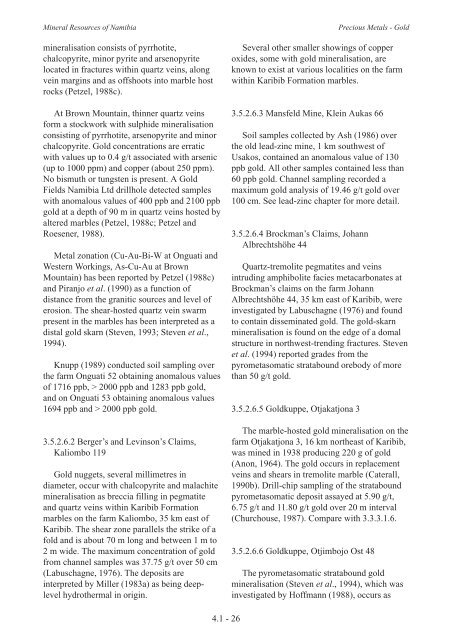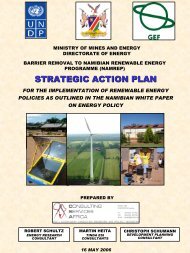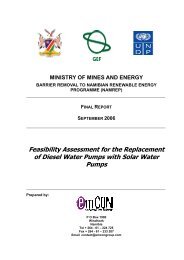Gold Chapter (855 KB) - Ministry of Mines and Energy
Gold Chapter (855 KB) - Ministry of Mines and Energy
Gold Chapter (855 KB) - Ministry of Mines and Energy
You also want an ePaper? Increase the reach of your titles
YUMPU automatically turns print PDFs into web optimized ePapers that Google loves.
Mineral Resources <strong>of</strong> Namibia Precious Metals - <strong>Gold</strong><br />
mineralisation consists <strong>of</strong> pyrrhotite,<br />
chalcopyrite, minor pyrite <strong>and</strong> arsenopyrite<br />
located in fractures within quartz veins, along<br />
vein margins <strong>and</strong> as <strong>of</strong>fshoots into marble host<br />
rocks (Petzel, 1988c).<br />
At Brown Mountain, thinner quartz veins<br />
form a stockwork with sulphide mineralisation<br />
consisting <strong>of</strong> pyrrhotite, arsenopyrite <strong>and</strong> minor<br />
chalcopyrite. <strong>Gold</strong> concentrations are erratic<br />
with values up to 0.4 g/t associated with arsenic<br />
(up to 1000 ppm) <strong>and</strong> copper (about 250 ppm).<br />
No bismuth or tungsten is present. A <strong>Gold</strong><br />
Fields Namibia Ltd drillhole detected samples<br />
with anomalous values <strong>of</strong> 400 ppb <strong>and</strong> 2100 ppb<br />
gold at a depth <strong>of</strong> 90 m in quartz veins hosted by<br />
altered marbles (Petzel, 1988c; Petzel <strong>and</strong><br />
Roesener, 1988).<br />
Metal zonation (Cu-Au-Bi-W at Onguati <strong>and</strong><br />
Western Workings, As-Cu-Au at Brown<br />
Mountain) has been reported by Petzel (1988c)<br />
<strong>and</strong> Piranjo et al. (1990) as a function <strong>of</strong><br />
distance from the granitic sources <strong>and</strong> level <strong>of</strong><br />
erosion. The shear-hosted quartz vein swarm<br />
present in the marbles has been interpreted as a<br />
distal gold skarn (Steven, 1993; Steven et al.,<br />
1994).<br />
Knupp (1989) conducted soil sampling over<br />
the farm Onguati 52 obtaining anomalous values<br />
<strong>of</strong> 1716 ppb, > 2000 ppb <strong>and</strong> 1283 ppb gold,<br />
<strong>and</strong> on Onguati 53 obtaining anomalous values<br />
1694 ppb <strong>and</strong> > 2000 ppb gold.<br />
3.5.2.6.2 Berger’s <strong>and</strong> Levinson’s Claims,<br />
Kaliombo 119<br />
<strong>Gold</strong> nuggets, several millimetres in<br />
diameter, occur with chalcopyrite <strong>and</strong> malachite<br />
mineralisation as breccia filling in pegmatite<br />
<strong>and</strong> quartz veins within Karibib Formation<br />
marbles on the farm Kaliombo, 35 km east <strong>of</strong><br />
Karibib. The shear zone parallels the strike <strong>of</strong> a<br />
fold <strong>and</strong> is about 70 m long <strong>and</strong> between 1 m to<br />
2 m wide. The maximum concentration <strong>of</strong> gold<br />
from channel samples was 37.75 g/t over 50 cm<br />
(Labuschagne, 1976). The deposits are<br />
interpreted by Miller (1983a) as being deeplevel<br />
hydrothermal in origin.<br />
4.1 - 26<br />
Several other smaller showings <strong>of</strong> copper<br />
oxides, some with gold mineralisation, are<br />
known to exist at various localities on the farm<br />
within Karibib Formation marbles.<br />
3.5.2.6.3 Mansfeld Mine, Klein Aukas 66<br />
Soil samples collected by Ash (1986) over<br />
the old lead-zinc mine, 1 km southwest <strong>of</strong><br />
Usakos, contained an anomalous value <strong>of</strong> 130<br />
ppb gold. All other samples contained less than<br />
60 ppb gold. Channel sampling recorded a<br />
maximum gold analysis <strong>of</strong> 19.46 g/t gold over<br />
100 cm. See lead-zinc chapter for more detail.<br />
3.5.2.6.4 Brockman’s Claims, Johann<br />
Albrechtshöhe 44<br />
Quartz-tremolite pegmatites <strong>and</strong> veins<br />
intruding amphibolite facies metacarbonates at<br />
Brockman’s claims on the farm Johann<br />
Albrechtshöhe 44, 35 km east <strong>of</strong> Karibib, were<br />
investigated by Labuschagne (1976) <strong>and</strong> found<br />
to contain disseminated gold. The gold-skarn<br />
mineralisation is found on the edge <strong>of</strong> a domal<br />
structure in northwest-trending fractures. Steven<br />
et al. (1994) reported grades from the<br />
pyrometasomatic stratabound orebody <strong>of</strong> more<br />
than 50 g/t gold.<br />
3.5.2.6.5 <strong>Gold</strong>kuppe, Otjakatjona 3<br />
The marble-hosted gold mineralisation on the<br />
farm Otjakatjona 3, 16 km northeast <strong>of</strong> Karibib,<br />
was mined in 1938 producing 220 g <strong>of</strong> gold<br />
(Anon, 1964). The gold occurs in replacement<br />
veins <strong>and</strong> shears in tremolite marble (Caterall,<br />
1990b). Drill-chip sampling <strong>of</strong> the stratabound<br />
pyrometasomatic deposit assayed at 5.90 g/t,<br />
6.75 g/t <strong>and</strong> 11.80 g/t gold over 20 m interval<br />
(Churchouse, 1987). Compare with 3.3.3.1.6.<br />
3.5.2.6.6 <strong>Gold</strong>kuppe, Otjimbojo Ost 48<br />
The pyrometasomatic stratabound gold<br />
mineralisation (Steven et al., 1994), which was<br />
investigated by H<strong>of</strong>fmann (1988), occurs as




